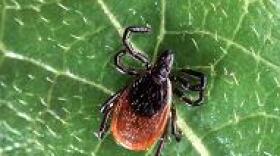With New York state budget negotiations ratcheting up in the final days, myriad groups are advocating for their funding needs — including advocates who want money for fighting Lyme disease.
The Senate budget proposal includes $1 million for Lyme and tick-borne disease initiatives. Hyde Park Republican Sue Serino, who chairs the Senate’s Task Force on Lyme and Tick Borne Diseases, says, since taking office, she has successfully fought for funding to be included in the final state budget after it was repeatedly left out of the executive proposal.
“And last year, we were able to get $1 million, which was amazing,” Serino says. “And it’s… the Cary Institute, when we give them $190,000, and that’s not a lot of money, but they do so much for research and education and prevention.”
Last year’s $1 million allocation was unprecedented in the state budget. Dr. Rick Ostfeld is a disease ecologist with the Millbrook-based Cary Institute of Ecosytem Studies. He says it’s a struggle without the funding.
“Well, it becomes quite a hardship for those of us who are working to better protect the public health against tick-borne disease. New York state is the, has the second highest number of cases of tick-borne disease in the U.S. We are a hotbed. There’s been a clear spread in the distribution of Lyme disease and other tick-borne diseases throughout virtually the entire state, with the possible exception of the High Peaks area in the Adirondacks but, even with climate change, the ticks are moving up in elevation. So there will soon by no part of the state that is untouched by tick borne disease,” Ostfeld says. “And the money funds the research to understand where that risk comes from, to ameliorate it, to try to reduce our probability of getting exposed, to educate our population, to work on better diagnostic and preventative and treatment measures, and all those would suffer if we don’t have funding in this year’s budget.”
Ostfeld is working on the Tick Project, a five-year study with Bard College that runs through 2021 and focuses on households throughout Dutchess County, with tick-killing interventions. Serino’s 41st District includes a large portion of Dutchess and part of Putnam County.
“And I don’t care who you ask, everybody knows somebody that’s had Lyme disease, and some much sicker than others, and young children,” Serino says. “It’s really, it’s horrible.”
“We do not want to get to the point where people don’t want to come visit our parks and outdoor spaces because they’re worried about Lyme and tick-borne disease,” Barrett says.
That’s Democratic Assemblymember Didi Barrett, who has long been an advocate for Lyme disease awareness and improved treatment. Barrett represents portions of Dutchess and Columbia Counties.
“It’s really important that we address this both from the health standpoint and the environmental standpoint. And I hope that the governor will recognize that,” says Barrett. “I think my colleagues in the Assembly understand this, and I trust that they will continue to be supportive in the ways that we can, but we really want the governor’s leadership on this as well.”
The Cary Institute’s Ostfeld says receiving funding is difficult outside of the state, and supplementing any federal funding advances the science.
“The important thing to note is that largely funding for this kind of research — disease, tick-borne diseases, environmental risks and things — comes from federal agencies, and they are continually strapped. And I think it is widely recognized in many circles that the federal agencies are not providing sufficient funds for tick-borne disease research,” says Ostfeld. “I think that is, in part, because it is not perceived as being a national problem when it is in a sense, it’s a very widespread problem, but there are parts of the country where risk is very low and disease incidence is low.”
In June, Governor Andrew Cuomo called Lyme and tick-borne disease one of the most pressing public health issues of our time. He said this while announcing a public-private research collaboration to advance the diagnosis and treatment of tick-borne diseases, with the state Department of Health Wadsworth Center Laboratory and biotech company Regeneron Pharmaceuticals. Meantime, legislation Barrett authored took effect in February — requiring signs informing visitors of the dangers of Lyme disease and tick-borne diseases be installed at state parks, trail entryways and campgrounds.









